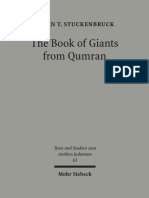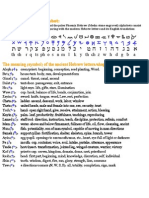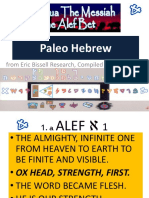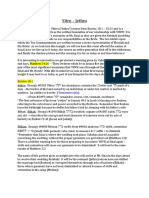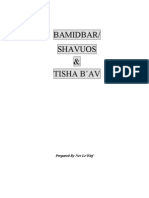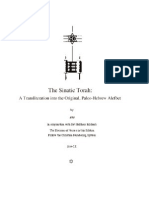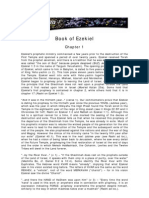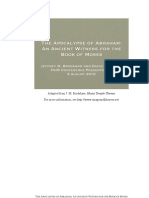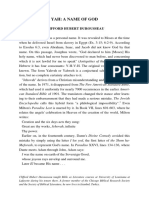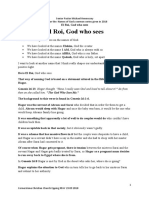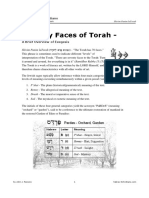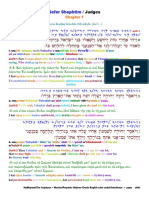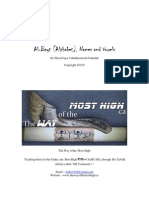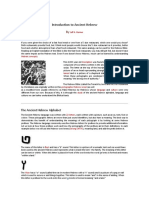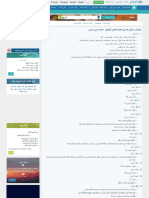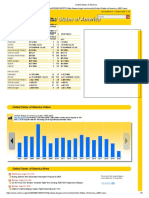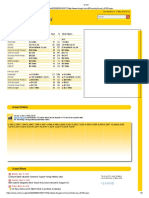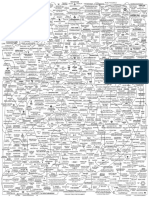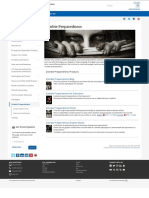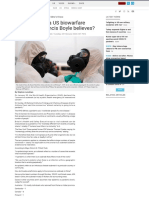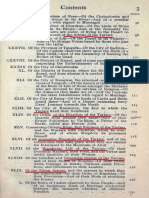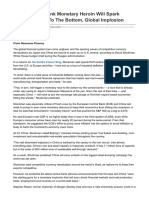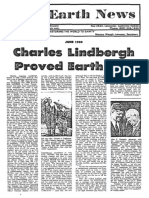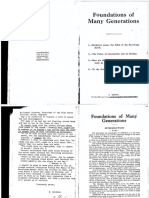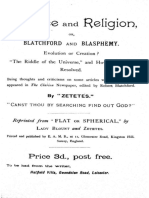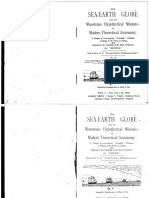Alef Beit
Alef Beit
Uploaded by
AbanoubCopyright:
Available Formats
Alef Beit
Alef Beit
Uploaded by
AbanoubOriginal Description:
Copyright
Available Formats
Share this document
Did you find this document useful?
Is this content inappropriate?
Copyright:
Available Formats
Alef Beit
Alef Beit
Uploaded by
AbanoubCopyright:
Available Formats
Modern
alef
bet
Some Meanings
Ox head
Ox, power, strength
leader, first
lamed
Tent
House, tent
mem
dalet
vav
Camel
Tent door
Camel,
carry, lift up
Door, pathway,
enter
Arms
extended
Behold, to reveal
Nail, peg
Nail, peg,
to secure
tet
yod
Cut off
samech
ayin
Some Meanings
Shepherd
staff
Control, speak,
authority
Water, chaos
Water, mighty,
blood
pay
Seed
sprout
Continue, activity,
life
Hand on
staff
Prop, turn, twist
slowly
Eye
Eye, see,
perceive, reveal
Mouth
Mouth, to speak,
a word
Fish hook
Fish hook, catch,
desire, need
Back of
the head
Back of the head,
behind, last, least
Head of
a man
A man, the highest,
a person, a head
tsadee
q
Fence, divided,
to reveal
kof
Snake,
basket
Snake, Surround
resh
Arm
and hand
Hand, make, my
shin
Palm
of hand
Teeth
Teeth, consume,
destroy
Palm, open
t
tav
Ancient Hebrew
Reveals Information
In Scripture
Jesus in the Hebrew Alef Bet
Fence
k
kaf
nun
zayin(zion) Weapon
chet
Ancient
Symbol
hay
l
m
g
gimmel
Modern
Ancient
Symbol
Crossed
Covenant, cross,
sticks
to seal, sign
Hebrew is truly a Holy language, providing much
more information in Hebrew Scripture than
common English Scripture translations provide.
To better understand what is being said in the
Hebrew Scriptures, it is helpful to understand the
way ancient Hebrew was written and the ancient
Hebrew characters such as those used by King
David, those used in parts of the Dead Sea
Scrolls, and in some Samaritan Scripture today.
Modern Hebrew characters are different from
ancient Hebrew. Modern Hebrew is easier to write
and came about during the Babylonian exile when
Jews started to use the squared-off form of letters
similar to those prevalent throughout the
Babylonian empire.
However, in ancient Hebrew, as in Chinese and
ancient Egyptian, the characters are pictures that
indicate the characters meaning. Words are
formed by combining the pictures and their
meanings, so knowing the associated ancient
picture for a character can reveal some amazing
information when interpreting Hebrew Scriptures.
Here we present some ancient meanings of several
Hebrew words used in Scripture and provide a
summary chart of modern and ancient Hebrew
characters and their meanings. There is debate
among scholars as to the present form of the
Hebrew letters and their original meanings.
Notice that Hebrew is read right to left.
Jesus Sacrifice in Word Torah
The Hebrew word h r w t is translated as
Torah in the English language and refers to the
first five books written by Moses.The following
shows ancient pictures for these Hebrew
characters that clarify the meaning of Torah:
= (t tav) meaning cross
This Hebrew word for create says that to create is
the Sons strength.
Hebrew people who reveal the Son
The word for Hebrew (the people of God)
comes from the word ahvar (r b u) which
means to cross over (as in cross over the Red
Sea, the Jordon River or death to life?).This word
contains the word for Son, (r b) adding the
letter Ayin.
= (u ayin) meaning reveal
= (w vav) meaning nail
= (r resh) meaning the highest(or a man)
= (h hay) meaning to reveal
Taking these characters and their meanings
together, we see that the word for Torah means
[To] a cross [is] nail[ed] the highest, it is
revealed [in the Torah].
Literally, this means that the Hebrew people are
the ones who reveal the Son.
Son is significant to several Hebrew words
The Hebrew word bar r b means a son. The
following shows ancient pictures for these Hebrew
characters:
= (b bet) meaning house
Covenant: the cross of My Son
Adding two letters to the Hebrew word for son
(r b) makes the word for covenant (breet or
t y r b). By adding the letter Yod (y) to the end of
a word, the Hebrew equivalent of my is formed.
When we add yod ( y ) to son ( r b), we get my
son. The letter tav is then added, which means a
cross. The characters added to Son (r b) are:
= (y yod) meaning my
= (t tav) meaning cross
= ( r resh) meaning man
Literally this means that the son is the man of (or
from) the house.
Literally, this says the covenant is the cross of
My Son.
The Word is the door of the Son
The Hebrew word meaning Word r b d is
pronounced devar.This word contains the word
for Son (r b), adding the letter Dalet.
Hebrew: the language of Scripture
Adding an ayin (u) onto the word for covenant
(above) gives the word for the Hebrew language
(eevreet or t y r b u)
= (u ayin) meaning reveal
= (d dalet) means door
Adding the meaning for dalet to the meaning for
Son literally means that the Word is the door of
the Son.
This says that the purpose of the Hebrew language
is to reveal the covenant (which is the cross of
My Son).
Create is the Sons strength
The Hebrew word meaning create a r b is
pronounced bara. This word contains the word
for son (r b), adding the letter alef.
= (a alef) meaning strength.
The blood of the Passover Lamb
When Jesus said He is the alpha and omega, the
beginning and the end (e.g. in Revelation 22:13),
He also spelled a Hebrew word, if you consider
the first and last letters (beginning and end) of the
Hebrew alphabet, as follows:
Alef (a) is the first letter of the Hebrew alphabet
Tav (t) is the final letter of the Hebrew alphabet
Vav (w ) is the letter that means and.
The ancient Hebrew letters are as follows:
= (alef a) the first letter
= (vav w ) and
= (tav t) the last letter
This word,
in ancient Hebrew (or t w a
in modern Hebrew), pronounced Oht means
the sign or the seal. This is the word used
for the blood of the lamb placed on the door
post on Passover (Exodus 12:7). Examining
the Hebrew letters more closely, we get:
= (alef a) meaning leader
= (vav w ) meaning nail
= (tav t) meaning cross
The blood placed on the doorpost on
Passover signifies the Leader nail[ed] [to
the] cross.
These are just some of the many fascinating
interpretations of Hebrew that enrich ones
understanding of Scripture. A summary of
Hebrew characters, their ancient pictures and
meanings follows. For more information, see the
following references:
Seekins, Frank T., Hebrew Word Pictures,
1994
Seekins, Frank T., The Gospel in Ancient
Hebrew, 1996
Church, J.R. and Stearman, Gary, The Mystery
of the Menorah and the Hebrew Alphabet, 1993
Rabbi Michael L. Munk, The Wisdom in the
Hebrew Alphabet, 1983, 1998
Return to God web site:
http://www.ReturnToGod.com
Copyright 2000 Return To God.
All Rights Reserved
P.O. Box 159, Carnation, WA 98014.
You might also like
- Revelation StudyDocument1,026 pagesRevelation StudyMegan Vivia van Wyk100% (2)
- 9783161587887Document57 pages9783161587887JennyGoodVibrationsClarkesonNo ratings yet
- Ancient Hebrew AlphabetDocument1 pageAncient Hebrew AlphabetJo-Ann Calmasini100% (4)
- Ancient Hebrew Flash CardsDocument11 pagesAncient Hebrew Flash CardsSigalitChana100% (4)
- The Conspiracy To Destroy All Existing Governments and Religions - Carr (1958)Document58 pagesThe Conspiracy To Destroy All Existing Governments and Religions - Carr (1958)Abanoub100% (3)
- Q3 - Keywords For Indepth SearchDocument1 pageQ3 - Keywords For Indepth SearchAbanoub100% (1)
- Lashawan QadashDocument10 pagesLashawan QadashYanzhiel AshimaNo ratings yet
- The Ancient Pictographic Hebrew Language1Document10 pagesThe Ancient Pictographic Hebrew Language1Tratul AbidNo ratings yet
- Teaching English To Hebrew Speakers: IdiomsDocument4 pagesTeaching English To Hebrew Speakers: Idiomsisrael_cohen_3No ratings yet
- By Sha'ul Ben YahukhananDocument8 pagesBy Sha'ul Ben YahukhananlarthNo ratings yet
- Hebrew AlphabetDocument3 pagesHebrew AlphabetJohn WarkowskiNo ratings yet
- Yichud Hashem: (Unification of The Name of G-D)Document7 pagesYichud Hashem: (Unification of The Name of G-D)liboaninoNo ratings yet
- Hebrew-The Old Testament Westminster Leningrad Codex Version 4-5-20051201Document740 pagesHebrew-The Old Testament Westminster Leningrad Codex Version 4-5-20051201lalo198No ratings yet
- 1 Paleo Hebrew Eric BissellDocument46 pages1 Paleo Hebrew Eric BissellAndreErasmus67% (3)
- Yitro - Jethro: ( Remember This)Document5 pagesYitro - Jethro: ( Remember This)David MathewsNo ratings yet
- Chumash Detail BamidbarDocument208 pagesChumash Detail BamidbarmalakimNo ratings yet
- Tikkun Kisay HaShemDocument47 pagesTikkun Kisay HaShemYochananMauritzHummasti100% (1)
- The Shema: The Testimony of YahushuaDocument20 pagesThe Shema: The Testimony of YahushuaCraig PetersNo ratings yet
- Let Us MakeDocument2 pagesLet Us MakeLew White100% (1)
- The Torah of The MessiahDocument7 pagesThe Torah of The MessiahJethro WoodNo ratings yet
- 3 Exodus PDFDocument148 pages3 Exodus PDFDUPLEX PRINT BOOKSNo ratings yet
- Paleo Hebrew TorahDocument163 pagesPaleo Hebrew TorahIsaiyah Carmona100% (2)
- Book of EzekielDocument71 pagesBook of Ezekielapi-3811809No ratings yet
- The Evidence of Perfect and Imperfect PentagramsDocument47 pagesThe Evidence of Perfect and Imperfect PentagramsRichter, JoannesNo ratings yet
- Chart PDFDocument1 pageChart PDFJuan Horacio Frias JavierNo ratings yet
- Bamidbar, בְּמִדְבַּרDocument7 pagesBamidbar, בְּמִדְבַּרDavid Mathews100% (1)
- Hebrew VocabDocument15 pagesHebrew VocabShirley Pigott MD100% (1)
- 2010 Apocalypse of AbrahamDocument54 pages2010 Apocalypse of AbrahammormonchessNo ratings yet
- Kabbalistic Curiosities (Cont.)Document5 pagesKabbalistic Curiosities (Cont.)DustinNo ratings yet
- YAH A Name of GodDocument6 pagesYAH A Name of GodAnselmo ViottiNo ratings yet
- BereishitDocument6 pagesBereishitDavid Mathews100% (1)
- Order of The 12 TribesDocument4 pagesOrder of The 12 TribesRabbi Benyomin HoffmanNo ratings yet
- Hebrew, #5475, Means Counsel, Confidentiality That Comes Only by Intimacy!Document9 pagesHebrew, #5475, Means Counsel, Confidentiality That Comes Only by Intimacy!David MathewsNo ratings yet
- The Name of God and The Linguistic Theory of The KabbalaDocument53 pagesThe Name of God and The Linguistic Theory of The KabbalaBartek Rudnicki100% (1)
- BEIT YISRAEL - Chafetz ChayimDocument192 pagesBEIT YISRAEL - Chafetz ChayimLiad Maccabi86% (7)
- Hebrew Letter PicturesDocument1 pageHebrew Letter PicturesrenehamburgerNo ratings yet
- Vayera - "And He Appeared": Vayera Elav Yahweh Be'eloney Mamre Vehu Yoshev Petach-Ha'ohel Kechom HayomDocument7 pagesVayera - "And He Appeared": Vayera Elav Yahweh Be'eloney Mamre Vehu Yoshev Petach-Ha'ohel Kechom HayomDavid MathewsNo ratings yet
- Names of GodDocument5 pagesNames of Godmoganero_1No ratings yet
- Learn Biblical Hebrew - Lesson 9 - Summary and WorksheetDocument7 pagesLearn Biblical Hebrew - Lesson 9 - Summary and WorksheetRoberto MerelliNo ratings yet
- Jewish Spirituality in The SiddurDocument3 pagesJewish Spirituality in The SiddurMeira HamiltonNo ratings yet
- The Moon of AvivDocument6 pagesThe Moon of AvivCraig PetersNo ratings yet
- El Roi - God Who Sees - Names of God Series 2018Document14 pagesEl Roi - God Who Sees - Names of God Series 2018meynardoNo ratings yet
- Mizvot PDFDocument77 pagesMizvot PDFRBKlejandria100% (1)
- ShemaDocument2 pagesShemaJoshua Michael McKennaNo ratings yet
- Seventy Faces of Torah - : Hebrew For ChristiansDocument4 pagesSeventy Faces of Torah - : Hebrew For ChristiansVladimir RomeroNo ratings yet
- Fasting, Wisdom, and The MessengersDocument2 pagesFasting, Wisdom, and The MessengersCraig PetersNo ratings yet
- Letter To The ColossiansDocument18 pagesLetter To The ColossiansounbblNo ratings yet
- Mt26 17 Mission ImpossibleDocument2 pagesMt26 17 Mission ImpossibleLew WhiteNo ratings yet
- Intelinear BibleDocument211 pagesIntelinear BibleSimone smsgNo ratings yet
- Acient Hebrew ToráDocument355 pagesAcient Hebrew Toráandre da conceição marcelinoNo ratings yet
- What Different Things Symbolize in The BibleDocument31 pagesWhat Different Things Symbolize in The BibleErnest RossNo ratings yet
- Grammatical Remarks: 1. The Hebrew Aleph-BethDocument6 pagesGrammatical Remarks: 1. The Hebrew Aleph-BethprogramandosumusicaNo ratings yet
- The Star of David's 12 Sides & 12 Segments of The 12 Tribes of IsraelDocument14 pagesThe Star of David's 12 Sides & 12 Segments of The 12 Tribes of IsraelJason Nicholas Corning100% (1)
- Genesis DecodedDocument217 pagesGenesis Decodedapi-204785694100% (2)
- The Hebrew Revelation, James and Jude: ספר אלה הסודות, אגרת יעקב ואגרת יהודהFrom EverandThe Hebrew Revelation, James and Jude: ספר אלה הסודות, אגרת יעקב ואגרת יהודהNo ratings yet
- Hebrew Decoded! Vol I: Signs Language of Adam- Ancient Language Master Key, Untold Story of LanguageFrom EverandHebrew Decoded! Vol I: Signs Language of Adam- Ancient Language Master Key, Untold Story of LanguageRating: 5 out of 5 stars5/5 (1)
- Al BaytDocument11 pagesAl Baytxdboy2006No ratings yet
- Kabbala GenesisDocument5 pagesKabbala GenesiscirrconniNo ratings yet
- The Ancient Hebrew AlphabetDocument7 pagesThe Ancient Hebrew AlphabetArnoldo OrtizNo ratings yet
- Introduction To Hebrew Healing LettersDocument11 pagesIntroduction To Hebrew Healing LettersKoop Da VilleNo ratings yet
- تعريف و شرح و معنى إله بالعربي في معاجم اللغة العربية معجم المعاني الجامع، المعجم الوسيط ،اللغة العربية المعاصر ،الرائد ،لسان العرب ،القاموس المحيط -Document4 pagesتعريف و شرح و معنى إله بالعربي في معاجم اللغة العربية معجم المعاني الجامع، المعجم الوسيط ،اللغة العربية المعاصر ،الرائد ،لسان العرب ،القاموس المحيط -AbanoubNo ratings yet
- List of Countries Forecast 2025 - DeagelDocument3 pagesList of Countries Forecast 2025 - DeagelAbanoub100% (5)
- United States of America - DeagelDocument3 pagesUnited States of America - DeagelAbanoubNo ratings yet
- Israel - DeagelDocument3 pagesIsrael - DeagelAbanoubNo ratings yet
- Q2 - Keywords For Indepth SearchDocument1 pageQ2 - Keywords For Indepth SearchAbanoub100% (1)
- Zombie Preparedness - CDCDocument1 pageZombie Preparedness - CDCAbanoubNo ratings yet
- Is Coronavirus A US BiowarfareDocument5 pagesIs Coronavirus A US BiowarfareAbanoubNo ratings yet
- Tartaria Book 4Document1 pageTartaria Book 4Abanoub100% (2)
- Cherubim and The Flaming SwordDocument5 pagesCherubim and The Flaming SwordAbanoubNo ratings yet
- Newtons Date For The CrucifixionDocument5 pagesNewtons Date For The CrucifixionAbanoubNo ratings yet
- BS 9.6.14 Mystery of The Shemitah Year Economic Collapses and Ephraim 65 YearsDocument9 pagesBS 9.6.14 Mystery of The Shemitah Year Economic Collapses and Ephraim 65 YearsAbanoubNo ratings yet
- More Central Bank Monetary Heroin Will Spark Currency Race To The Bottom, Global ImplosionDocument2 pagesMore Central Bank Monetary Heroin Will Spark Currency Race To The Bottom, Global ImplosionAbanoubNo ratings yet
- Flat or Spherical - 07 - EarthDocument18 pagesFlat or Spherical - 07 - EarthAbanoub100% (2)
- Flat Earth Society Newsletter - 1980 JuneDocument6 pagesFlat Earth Society Newsletter - 1980 JuneAbanoubNo ratings yet
- Foundations of Many Generations (E. Eschini)Document25 pagesFoundations of Many Generations (E. Eschini)AbanoubNo ratings yet
- Flat or Spherical - 03 - Science and ReligionDocument20 pagesFlat or Spherical - 03 - Science and ReligionAbanoubNo ratings yet
- Sea-Earth Globe, The (Zetetes) PDFDocument22 pagesSea-Earth Globe, The (Zetetes) PDFAbanoubNo ratings yet

